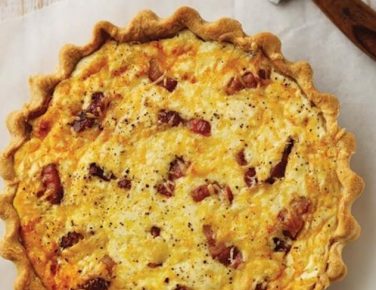
Quark Quiche Lorraine
Great enjoyed hot or cold, this quiche recipe is sure to be loved by all the family.

This is one of James’s favourite recipes, of all time. If you’ve never tried baking bread before, please try this one.
20 minutes
1 hour
Medium
5
There’s just something about bread and potatoes. The carb on carb. The chip butty. The tattie scone. It just works. It sweeps you off into a place where the now defunct Atkins diet was just a dream. Bliss.
First, weigh your flour into a large bowl and then rub your yeast and salt into it on opposite sides of the pile. Add in your water and olive oil and mix everything together with a wooden spoon until it comes together into a wet, sticky dough.
Cover the bowl with cling film or a wet tea towel and leave it at room temperature for 30-60 minutes. You’ll notice it changes a bit in this time; it won’t rise properly but will a wee bit. There’s no need for a warm place.
After this time has elapsed, wet one hand and fold the dough over inside the bowl, forcing any air out. You’ll notice it’s soft and stretchy – this is actually what a properly kneaded dough looks like. Your rest has replaced the kneading.
Once you’ve forced all the air out, re-cover the dough. Leave it for an hour or so at room temperature, during which time it should nearly double in size. Alternatively, chuck it in the fridge for longer, up to overnight or even a day or two. This will make the flavour world class, should you choose to do so.
Drizzle oil onto your tray or tin to stop it sticking then scoop your risen dough onto it. Using oiled fingertips, push the dough to the edges and corners.
Chop up your potatoes into small squares and cover the top with as many as you like, then sprinkle on the rosemary, sea salt and a bit more olive oil. Leave this prove for another half an hour to an hour. During this time, preheat your oven to 220C/200C fan/Gas 7.
Bake your focaccia for 35-45 minutes or until suitably golden brown in colour. Turn the bread out from the tin and drizzle it in more olive oil, preferably extra virgin.
In bread making, it’s not common practice to line your tin or tray with baking paper – it potentially means your bottom won’t be quite as crisp as if it was in contact with the bare metal. However, if you don’t have a non-stick pan, I’d recommend it, as a stuck bread is the worst feeling in the world.
Enjoy!